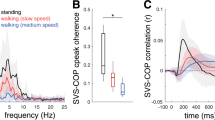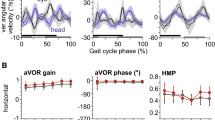Summary
This experiment, which extends a previous investigation (Pozzo et al. 1990), was undertaken to examine how head position is controlled during natural locomotor tasks in both normal subjects (N) and patients with bilateral vestibular deficits (V). 10 normals and 7 patients were asked to perform 4 locomotor tasks: free walking (W), walking in place (WIP), running in place (R) and hopping (H). Head and body movements were recorded with a video system which allowed a computed 3 dimensional reconstruction of selected points in the sagittal plane. In order to determine the respective contribution of visual and vestibular cues in the control of head angular position, the 2 groups of subjects were tested in the light and in darkness. In darkness, the amplitude and velocity of head rotation decreased for N subjects; these parameters increased for V subjects, especially during R and H. In darkness, compared to the light condition, the mean position of a line placed on the Frankfort plane (about 20–30° below the horizontal semi-circular canal plane) was tilted downward in all conditions of movement, except during H, for N subjects. In contrast, this flexion of the head was not systematic in V subjects: the Frankfort plane could be located above or below earth horizontal. In V subjects, head rotation was not found to be compensatory for head translation and the power spectrum analysis shows that head angular displacements in the sagittal plane contain mainly low frequencies (about 0.3–0.8 Hz). The respective contribution of visual and vestibular cues in the control of the orientation and the stabilization of the head in space is discussed.
Similar content being viewed by others
References
Allum JHJ, Mauritz KH (1985) Visual and vestibular contributions to pitch sway stabilization in the ankles muscles of normals and patients with bilateral peripheral vestibular deficits. Exp Brain Res 58:82–94
Black FO, Wall C, Nashner LM (1983) Effect of visual and support surface orientation references upon postural control in vestibular deficient subjects. Acta Otolaryngol 95:199–210
Brindley GS (1965) How does an animal that is dropped in a non-upright posture know the angle through which it must turn in the air so that its feet point to the ground? J Physiol 180:24–44
Bronstein AM (1988) Evidence for a vestibular input contributing to dynamic head stabilization in man. Acta Otolaryngol 105:1–6
Clément G, Vieville T, Lestienne F, Berthoz A (1986) Modification of gain assymetry and beating field of vertical optokinetic nystagmus in microgravity. Neurosci Lett 63:271–274
D'Amico F, Ferrigno G (1990) Technique for the evaluation of derivatives from noisy biomechanical displacement data using a model-based bandwith-selection procedure. Med Biol Cop 24:407–415
De Beer GR (1947) How animals hold their heads. Proc Linn Soc London 159:125–139
Denise P, Corvisier J, Berthoz (1989) Eye movements and neck muscle activity after unilateral labyrinthectomy in the cat. In: Lacour M, Denise P, Toupet M, Christen Y (eds) Vestibular compensation: facts, theories and clinical perspectives. Elsevier, Paris, pp 59–72
De Waele C, Graaf W, Josset P, Vidal PP (1989) A radiological analysis of the postural syndromes following hemilabyrinthectomy and selective canal and otolith lesions in the guinea pig. Exp Brain Res 77:166–18
Droulez J, Darlot C (1989) The geometric and dynamic implications of the coherence constraints in the three dimensional sensorimotor interactions. In: Jeannerod M (ed) Attention and performance, Vol XII, 17. Lawrence Erlbaum, Hillsdale NJ, pp 495–525
Freyss G, Vitte E, Semont A, Tran-Ba-Huy P, Gaillard P (1988) Computation of eye-head movements in oscillopsic patients: modifications induced by reeducation. Adv Oto Rhino Laryng 42:294–300
Freyss G, Vitte E, Semont A, Meligy EL, Gaillard P (1989) An otoligical and physiotherapeutic assessment of vestibular compensation in humans. In: Lacour M, Denise P, Toupet M, Christen Y (eds) Vestibular compensation: facts, theories and clinical perspectives. Elsevier, Paris, pp 261–274
Greenwood R, Hopkins A (1976) Muscle response during sudden falls in man. J Neurophysiol 254:507–518
Gresty M (1987) Stability of the head: studies in normal subjects and in patients with labyrinthine disease, head tremor, and dystonia. Mov Disord 1:165–185
Grossman GE, Leigh RJ, Bruce E, Huebner WP, Lanska DJ (1989) Performance of the human vestibuloocular reflex during locomotion. J Neurophysiol 62:264–272
Guitton D, Kearney RE, Wereley N, Peterson BW (1986) Visual, vestibular and voluntary contribution to human head stabilization. Exp Brain Res 64:59–69
Longridge NS, Mallinson AI (1987) The dynamic illegible e-test. Acta Otolaryngol 103:273–279
Mayne R (1974) A system concept of the vestibular organs. In: Kornhuber HH (ed) Handbook of sensory physiology: vestibular system, Vol VI/2. Springer, New York, pp 493–580
Melvill Jones G, Young LR (1968) Subjective detection of the vertical acceleration: a velocity dependent response. Acta Otolaryngol 85:45–53
Melvill Jones G, Watt DGD (1971) Observations on the control of stepping and hopping movements in man. J Physiol 219:709–727
Melvill Jones G, Watt DGD (1971) Muscular control of landing from unexpected falls in man. J Physiol 219:729–737
Melvill Jones G, Watt DGD, Rossignol S (1973) Eight nerve contributions to the synthesis of locomotor control. In: Stein RB, Pearson KB (eds) Control of posture and locomotion. Plenum, New York, pp 579–597
Money KE, Scott JW (1962) Functions of separate sensory receptors of non-auditory labyrinth of the cat. Am J Physiol 202:1211–1220
Paige GD (1989) The influence of target distance on eye movement responses during vertical linear motion. Exp Brain Res 77:585–593
Pozzo T, Berthoz A, Lefort L (1990) Head stabilization during various locomotor tasks in humans. I. Normal subjects. Exp Brain Res 82:97–106
Roberts TD (1967) Neurophysiology of postural mechanisms. Butterworths, London
Rossignol S, Melvill Jones G (1976) Audio-spinal influence in man studied by the H-reflexe and its possible role on the rythmic movements synchronized to sound. Electroenceph Clin Neurophysiol 41:83–92
Vidal PP, Graf LV, Berthoz A (1986) The orientation of the cervical column in unrestrained awake animals. I. Resting position. Exp Brain Res 61:549–559
Watt DGD (1976) Responses of cats to sudden falls: an otolith-originating reflex assisting landing. J Neurophysiol 39:257–265
Watt DGD (1981) Effects of vertical linear acceleration on H-reflex in decerebrate cat. II. Sinusoidal stimuli. J Neurophysiol 45:656–667
Author information
Authors and Affiliations
Rights and permissions
About this article
Cite this article
Pozzo, T., Berthoz, A., Lefort, L. et al. Head stabilization during various locomotor tasks in humans. Exp Brain Res 85, 208–217 (1991). https://doi.org/10.1007/BF00230002
Received:
Accepted:
Issue Date:
DOI: https://doi.org/10.1007/BF00230002




